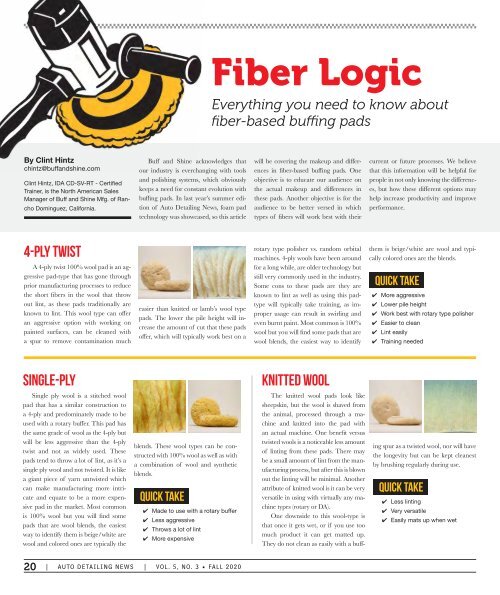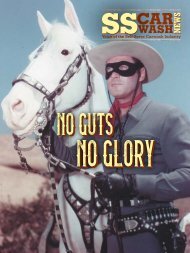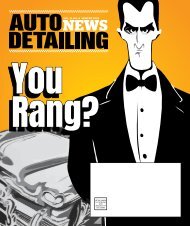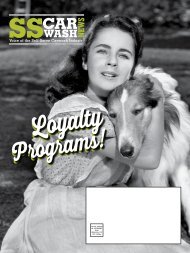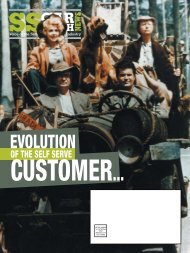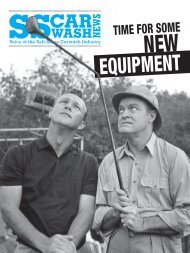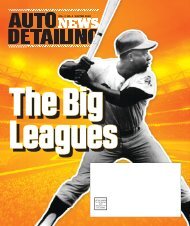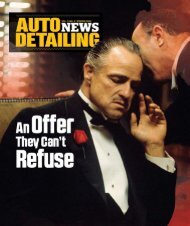2020_ADN_V5_No3_web
You also want an ePaper? Increase the reach of your titles
YUMPU automatically turns print PDFs into web optimized ePapers that Google loves.
Fiber Logic<br />
Everything you need to know about<br />
fiber-based buffing pads<br />
By Clint Hintz<br />
chintz@buffandshine.com<br />
Clint Hintz, IDA CD-SV-RT - Certified<br />
Trainer, is the North American Sales<br />
Manager of Buff and Shine Mfg. of Rancho<br />
Dominguez, California.<br />
Buff and Shine acknowledges that<br />
our industry is everchanging with tools<br />
and polishing systems, which obviously<br />
keeps a need for constant evolution with<br />
buffing pads. In last year’s summer edition<br />
of Auto Detailing News, foam pad<br />
technology was showcased, so this article<br />
will be covering the makeup and differences<br />
in fiber-based buffing pads. One<br />
objective is to educate our audience on<br />
the actual makeup and differences in<br />
these pads. Another objective is for the<br />
audience to be better versed in which<br />
types of fibers will work best with their<br />
current or future processes. We believe<br />
that this information will be helpful for<br />
people in not only knowing the differences,<br />
but how these different options may<br />
help increase productivity and improve<br />
performance.<br />
4-PLY TWIST<br />
A 4-ply twist 100% wool pad is an aggressive<br />
pad-type that has gone through<br />
prior manufacturing processes to reduce<br />
the short fibers in the wool that throw<br />
out lint, as these pads traditionally are<br />
known to lint. This wool type can offer<br />
an aggressive option with working on<br />
painted surfaces, can be cleaned with<br />
a spur to remove contamination much<br />
easier than knitted or lamb’s wool type<br />
pads. The lower the pile height will increase<br />
the amount of cut that these pads<br />
offer, which will typically work best on a<br />
rotary type polisher vs. random orbital<br />
machines. 4-ply wools have been around<br />
for a long while, are older technology but<br />
still very commonly used in the industry.<br />
Some cons to these pads are they are<br />
known to lint as well as using this padtype<br />
will typically take training, as improper<br />
usage can result in swirling and<br />
even burnt paint. Most common is 100%<br />
wool but you will find some pads that are<br />
wool blends, the easiest way to identify<br />
them is beige/white are wool and typically<br />
colored ones are the blends.<br />
Quick Take<br />
✔ More aggressive<br />
✔ Lower pile height<br />
✔ Work best with rotary type polisher<br />
✔ Easier to clean<br />
✔ Lint easily<br />
✔ Training needed<br />
SINGLE-PLY<br />
KNITTED WOOL<br />
Single ply wool is a stitched wool<br />
pad that has a similar construction to<br />
a 4-ply and predominately made to be<br />
used with a rotary buffer. This pad has<br />
the same grade of wool as the 4-ply but<br />
will be less aggressive than the 4-ply<br />
twist and not as widely used. These<br />
pads tend to throw a lot of lint, as it’s a<br />
single ply wool and not twisted. It is like<br />
a giant piece of yarn untwisted which<br />
can make manufacturing more intricate<br />
and equate to be a more expensive<br />
pad in the market. Most common<br />
is 100% wool but you will find some<br />
pads that are wool blends, the easiest<br />
way to identify them is beige/white are<br />
wool and colored ones are typically the<br />
blends. These wool types can be constructed<br />
with 100% wool as well as with<br />
a combination of wool and synthetic<br />
blends.<br />
Quick Take<br />
✔ Made to use with a rotary buffer<br />
✔ Less aggressive<br />
✔ Throws a lot of lint<br />
✔ More expensive<br />
The knitted wool pads look like<br />
sheepskin, but the wool is shaved from<br />
the animal, processed through a machine<br />
and knitted into the pad with<br />
an actual machine. One benefit versus<br />
twisted wools is a noticeable less amount<br />
of linting from these pads. There may<br />
be a small amount of lint from the manufacturing<br />
process, but after this is blown<br />
out the linting will be minimal. Another<br />
attribute of knitted wool is it can be very<br />
versatile in using with virtually any machine<br />
types (rotary or DA).<br />
One downside to this wool-type is<br />
that once it gets wet, or if you use too<br />
much product it can get matted up.<br />
They do not clean as easily with a buffing<br />
spur as a twisted wool, nor will have<br />
the longevity but can be kept cleanest<br />
by brushing regularly during use.<br />
Quick Take<br />
✔ Less linting<br />
✔ Very versatile<br />
✔ Easily mats up when wet<br />
20 | AUTO DETAILING NEWS | VOL. 5, NO. 3 • FALL <strong>2020</strong>


